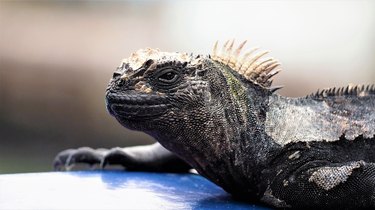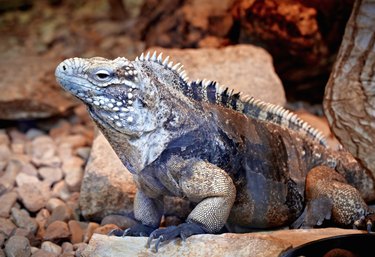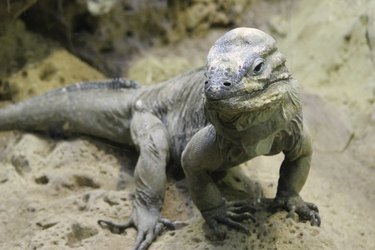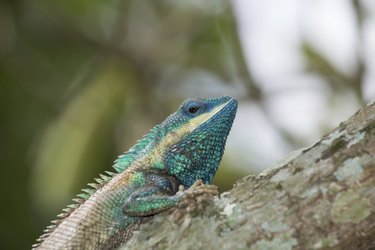Today, almost all iguana species native to the Americas and sold in pet stores, such as green iguanas, Cuban rock iguanas, and rhinoceros iguanas, are bred in captivity but endangered in the wild. Common features of all iguana species include a pendulous fold of skin called a dewlap under their throats, a row of spiky-looking protrusions called a dorsal crest running along their backs, and long tails. Even though these prehistoric-looking lizards are typically sold when they're small, they grow up to be extremely large animals requiring a lot of living space and specialized care. Learn exactly what kind of a commitment you would need to make before considering adoption.

Video of the Day
"Green" iguanas: not always green
Green iguanas are the most popular species sold as pets in the U.S. However, the name is somewhat misleading, since they come in a wide range of other colors and color combinations, including brown, orange, and blue. These iguanas also regularly change color in response to such factors as status in the pecking order, health, age, mood, time of day, and ambient temperature.
Video of the Day
Even though green iguanas are common reptile pets in pet stores, few people who adopt a baby are equipped to care for the "dinosaur with special needs" when it's fully grown, In the wild, they're found from Mexico throughout Central and South America, where they live in forests and spend most of their lives basking in trees.
The long-lived cuban rock iguana

Even though the ground-dwelling Cuban rock iguana doesn't grow as large as the green iguana, this lizard reaches lengths of five feet and weighs up to 15 pounds. These iguanas, members of the Cyclura species, live in colonies all over Cuba and nearby islands and with the right care, have a life expectancy of 50 years or more.
While the Cuban rock iguana is one of the easiest Cyclura species to tame, these types of iguanas have complex care needs, including a large outdoor enclosure with basking areas. This lizard must be handled with care, since one snap of its powerful jaws can take off a finger or toe.
Young Cuban rock iguanas tend to be dark brown or green with darker-colored bands on their bodies. Adult coloring in males ranges from dark gray to brick red while most females are olive green with darker stripes or bands.
The rhinoceros iguana

Both the color and the horn-like protrusions growing on the snouts of male rhinoceros iguanas lend them a resemblance to the African land mammal that inspired their name. Native to Haiti and the Dominican Republic on the Caribbean island of Hispaniola, rhino iguanas grow to a length of about 4 1/2 feet but in proportion to size, are heavier and bulkier than green iguanas.
Their preferred habitat is dry, rocky forests in coastal areas and scrub woodlands where their drab coloring — grayish brown to black — provides them with camouflage. They have a life expectancy of 20-plus years.
Morphs and mutants: "designer" types of iguanas

The past success of selectively breeding ball pythons to produce snakes with unusual colors and markings has inspired many reptile breeders to take a similar approach to breeding iguanas. Today, many are focusing their efforts on producing "morphs" and mutants unlike any ever seen in the wild because the more unique an iguana's appearance, the higher its value to reptile enthusiasts.
In terms of reptile genetics, "axanthic" means lacking the gene that produces the color yellow. Breeding the yellow gene out of green iguanas has produced brilliant-hued axanthic blue iguanas. Similarly, crossing a yellow albino iguana with an axanthic blue iguana yields a snow-white iguana with pink eyes known as the "blizzard lizard." Other genetic manipulations and lucky breeding accidents have produced still more striking colors, color combinations, and patterns.